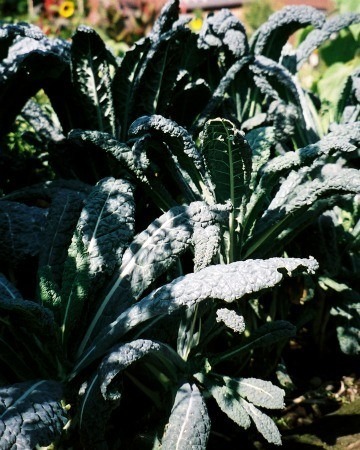Ribollita 'Da Delfina' Recipe
Ribollita 'Da Delfina' Recipe
Ribollita is a classic Tuscan soup traditionally made with leftover minestrone thickened with chunks of stale bread. This version is something quite different, and it’s based entirely on the one they serve at Ristorante Da Delfina, a wonderful ristorante in a tiny village nestled in the hills just outside Florence.
The first time I ate it, I didn’t know what to expect, and since I am not a soup person, I was pleasantly surprised to discover that they’d turned the soup into something wholly un-soup-like that I could eat with a knife and fork. The way we make it, after cooking off the liquid, we thicken the soup with bread, chill it, and then shape it into patties that are pan-fried in olive oil.
We serve it as an antipasto, but it could be a side dish or if served with a green salad, a light meal. I often recommend it to vegetarians, and to make it vegan, just omit the Parmigiano rind. One of our inveterate recipe testers, Tracey Harada, tested this recipe about eight times to get the flavors perfect. Cavolo nero, a variety of kale, is one of the defining ingredients of any ribollita.
Click here to see Nancy Silverton's Thanksgiving Dinner.
Servings
8

Ingredients
- 1 cup plus 2 tablespoons extra-virgin olive oil, plus more as needed
- 2 cup yellow spanish onion, cut into a large dice
- 1 cup rutabaga, peeled and cut into a large dice
- 1 cup carrot, cut into a large dice
- 1 cup butternut squash, cut into a large dice
- 1 cup fennel, cut into a large dice
- 4 teaspoon kosher salt
- 3 cup packed savoy cabbage or napa cabbage, chopped coarsely
- 3 cup packed cavolo nero, stemmed and chopped coarsely
- 3 cup canned whole peeled tomatoes, preferably san marzano
- 1 or 2 parmigiano-reggiano rinds
- 1 cup water
- 1/2 pound stale, crustless bread, broken up into small chunks
- finishing-quality extra-virgin olive oil, for drizzling
- wedge of parmigiano-reggiano, for grating
Directions
- Combine ½ cup of the olive oil with the onion, rutabaga, carrot, squash, and fennel in a large sauté pan over medium-low heat. Season with 2 teaspoons of the salt, and cook to sweat the vegetables for about 10-15 minutes, stirring occasionally to prevent them from browning, until they are tender. Reduce the heat to medium-low and let the vegetables sweat in their own juices another 8-10 minutes, until they’re very soft.
- Add the cabbage and cavolo nero, season with the remaining the salt, and cook to wilt the cabbages slightly, about 2 minutes. Reduce the heat to low, add ½ cup of the remaining olive oil, and cook without stirring until the juices released from the vegetables have boiled down and the pan is almost dry, about 15 minutes.
- Break the tomatoes up into the pan. Add the Parmigiano-Reggiano rind and the water, and cook the soup at a low simmer for 2 ½-3 hours, adding another cup of water from time to time so the vegetables are always barely covered with water, until the root vegetables are very tender but not disintegrated.
- When the vegetables are done, continue to cook until there is no water left in the pan and the soup is stiff enough that you can stand a wooden spoon straight up in it.
- Transfer the soup to a large mixing bowl and remove and discard the Parmigiano-Reggiano rind. Add the bread and beat it vigorously into the soup with a wooden spoon so it breaks up and is suspended in the soup. (If you have large chunks of bread in the soup, it will cause the patties to fall apart when you fry them.)
- Set the soup aside to cool to room temperature, then cover the bowl tightly with plastic or transfer the soup to an airtight container and refrigerate it overnight or for at least 1 hour. The soup can be made to this point up to 5 days in advance.
- Adjust the oven rack to the middle position and preheat the oven to 400 degrees.
- Scoop out 1 cup of soup and mold the soup between your palms as you would a hamburger patty, forming a square patty about 1-inch-thick, and place it on a baking sheet. Repeat, forming the remaining soup patties in the same way. Cover the baking sheet tightly with plastic wrap and place it in the refrigerator to chill the patties for at least 30 minutes before frying them. The patties can be formed up to 1 day in advance.
- Heat the remaining 2 tablespoons olive oil in a large nonstick skillet over medium-high heat until the oil is almost smoking and slides easily in the pan, 2-3 minutes. Add 2 or 3 of the soup patties, making sure to leave enough room so you can slide a spatula under and flip the patties.
- Fry the patties on the first side until they’re crisp and almost black in places, 5-6 minutes. Carefully turn the patties and cook them on the second side for 2 minutes. Transfer the patties without turning them (the crisp side will be facing up) to a baking sheet and place them in the oven while you fry the remaining patties in the same way, adding more olive oil to the pan as needed, and adding the fried patties to the baking sheet in the oven as they’re done.
- After the last patties have been fried, leave them all in the oven for 5 minutes to make sure the last batch is warmed through. Remove the patties from the oven and place each one on a plate with the crisp side facing up. Drizzle each serving with 1 tablespoon of the finishing-quality olive oil. Use a microplane or another fine grater to grate a generous layer of Parmigiano-Reggiano over each patty, and serve.